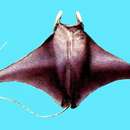Biology
provided by Arkive
The gregarious giant devilray tends to move around in groups, swimming close to the surface (2) (5). They apparently make long migrations (2), and show a preference for stretches of ocean traversed by strong currents (5). The giant devilray feeds on plankton and small pelagic fishes (1) (2) (5), which are strained out of the water (4). Their horn-like cephalic fins assist in feeding (5).
Giant devilrays are ovoviviparous (2), a method of reproduction in which embryos develop within eggs that remain inside the mother's body until they hatch. The gestation period is long, lasting about 25 months, and results in only one, or rarely two, pups born in summer (2). These newborn devilrays can measure up to an astonishing 180 centimetres in width (2).
Conservation
provided by Arkive
In 2005, the General Fisheries Commission for the Mediterranean adopted a measure to ban trawling below 1,000 metres and banned driftnets throughout the Mediterranean (6). This is likely to have substantially reduced the threat of by-catch to the giant devilray in the Mediterranean. Raising awareness with fishermen to maximise the number of giant devilrays that are disentangled and released unharmed after accidental capture has also been recommended as an important measure to protect this magnificent oceanic animal (1).
Description
provided by Arkive
This immense, graceful ray has large, pointed pectoral fins which enables it to traverse great stretches of ocean with gentle wing-like beats. The upper surface of the giant devilray is dark, whilst beneath it is mostly white (3). Species in the family Mobulidae are the only living vertebrates to possess three pairs of functioning limbs (4); the pectoral fins, pelvic fins and cephalic fins. The cephalic fins, which are situated on the head and point forward and slightly down (3), gave rise to their common name due to their resemblance to devil horns. The mouth is situated on the underside, between the cephalic fins, and at the base of the slender tail is a serrated spine (3) (5).
Habitat
provided by Arkive
The giant devilray inhabits offshore, deep waters and occasionally can also be found in shallow waters (1).
Range
provided by Arkive
Occurs in the Mediterranean and in the eastern Atlantic, from the English Channel south to Senegal, the Azores and the Canary Islands (1).
Status
provided by Arkive
Classified as Endangered (EN) on the IUCN Red List (1).
Threats
provided by Arkive
Although the giant devilray is not targeted by fisheries, it is accidentally captured at threatening levels, such as by swordfish and tuna fisheries (1) (2). A decline in habitat quality, particularly in the Mediterranean, is also likely to be impacting populations of giant devilray, though to what extent is not known (1). Its preference for inhabiting the surface of the oceans makes the giant devilray vulnerable to disturbance from maritime traffic and oil spills (1).

